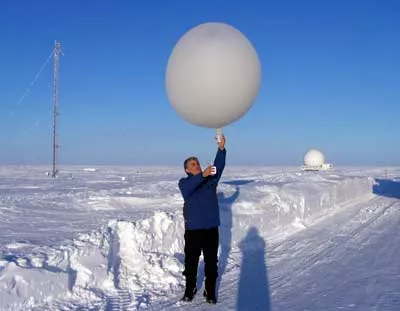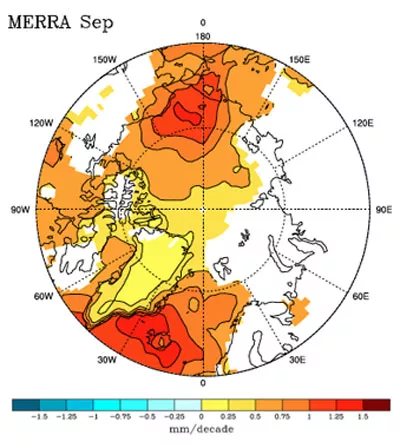By Jane Beitler
When it comes to climate change in the Arctic, melting sea ice and warming oceans often get the most attention. Yet in the atmosphere, another watery component is changing as well: water vapor. As sea ice extent and duration decrease and air temperatures rise, the increasingly open Arctic Ocean is subject to even more evaporation, pumping more water vapor into the atmosphere, making it more humid. In addition, warmer air is capable of holding more water, so increasing humidity over the Arctic may be yet another signal that air temperatures in the region are rising, producing yet another feedback mechanism throwing the Arctic climate off-kilter.
Looking backward to look forward
To understand how an increase in water vapor might play into the changing Arctic climate, NSIDC scientists Mark Serreze, Julienne Stroeve, and Andrew Barrett looked at data from radiosondes, instruments attached to weather balloons that are released into the atmosphere to measure things like temperature, air pressure, and relative humidity. The readings, collected between 1979 and 2010, provided evidence that not only were seasonal air temperatures increasing, but so was the humidity, or the amount of water vapor in the air.
Meteorological data from the radiosondes could only provide part of the picture. To place the findings in the larger context of Arctic climate, the team combined the radiosonde data with six different atmospheric reanalyses. Reanalyses assimilate historic climate data, such as from radiosondes or satellites, in a consistent fashion. This consistency minimizes anomalies and differences caused by things like changes in data collection methods, sensors, or parameters that may have occurred over time, making it easier to accurately compare data from different sources. Poring through several different reanalyses permitted the scientists to better identify long-term trends over the entire Arctic region.
Feeding the feedbacks
Between the radiosonde data and the reanalysis efforts, Serreze and his colleagues found consistent matches that often coincided with other signals of climate change. For instance, an increase in water vapor over the North Atlantic corresponded with regions of higher sea surface temperatures, particularly over the North Atlantic. Similarly, a rise in water vapor also occurred over the Beaufort and Chukchi Seas, areas where annual end-of-season sea ice loss during August and September has been most dramatic.
Increasing the amount of water vapor in the atmosphere is a feedback mechanism. Decreased sea ice extent is leaving larger areas of open water, leading to more evaporation into a slightly warmer atmosphere. Because water vapor is a greenhouse gas that traps heat in the atmosphere, higher humidity may cause further warming in the Arctic.
Of course, climate scientists expect some degree of seasonal and interannual variations in Arctic climate, but the amount of change they have observed is more noticeable and more rapid than elsewhere in the Northern Hemisphere. And the change is still underway: how this increase in humidity affects Arctic climate remains to be seen. Will more water vapor lead to increased rain or snowfall among Earth's higher latitudes? Or is the Arctic destined to remain a more humid, and perhaps more temperate, environment?
References
Serreze, M. C., A. P. Barrett, and J. Stroeve. Submitted. Recent changes in tropospheric water vapor over the Arctic as assessed from radiosondes and atmospheric reanalysis. Journal of Geophysical Research.

